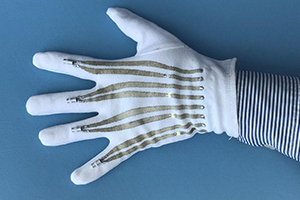
Wearable technology is on the cusp of a major transformation
YarnsandFibers News Bureau 2019-05-07 00:30:00 – United StatesHow many times have you seen a headline around “smart clothing†or “wearable tech†and you’ve been disappointed that the product doesn’t look so wearable at all? Personally, I don’t have enough fingers to count the amount, quite honestly. Despite being sold as "wearable", much of the time, wearable tech is cumbersome and awkward, and never really works as intuitively as you'd like.
Well, according to the people behind the development - a fresh piece of technology has been patented that allows electronic systems to be assembled directly onto textiles, enabling a new generation of “truly wearable†smart garments. Developed by a UK startup called Pireta, the innovation has the potential to transform the wearables industry due to its free-form printed circuit process, which allows electronic systems to be assembled directly onto textiles.
“Wearable technology is on the cusp of a major transformation. Wearable products are evolving from rigid devices – such as smartwatches and wrist bands – toward genuinely wearable smart garments based on electronic textiles or ‘e-textiles’,†said a Pireta news release.
“Unlike existing methods, our technology has no impact on the handle, drape, stretch or breathability of the fabric, enabling a new generation of truly wearable smart garments and e-textiles.â€
So how does it work? Pireta’s process attaches a thin, highly-durable metallic layer at the fiber level, resulting in excellent conductivity but with no impact on the performance of the textile. This means that electronics can be integrated into stretchable, breathable, washable smart garments that can be worn close to the body with ease and comfort, making them - what they call "truly wearable".
Although there is a concern that the technology wouldn’t be compatible with standard industry processes that use commercially-available equipment and low-cost chemistry. Saying that, Pireta claims that its textile tech can be applied to finished garments or fabric on the roll, making it suitable for both niche and mass markets.
“Applicable to a wide range of textiles and fabrics, Pireta’s process can be applied in wearable and e-textile applications targeted at numerous sectors, including healthcare, defence, sport, and fashion,†the firm explained.
Just last year, Gartner forecast that worldwide shipments of wearable devices will reach 225 million in 2019, an increase of 25.8 percent from 2018, and that smart clothing will be one of the fastest growing areas of the industry, increasing from 4.12 million shipments in 2017 to a predicted 19.91 million by 2022.
According to analysts, this trend is being enabled by the availability of new flexible sensors, batteries and other electronic components that have been developed with wear-ability in mind. However, major challenges remain in how to assemble and inter-connect these components on textiles and garments – particularly if the performance of the fabric is to be preserved.
Nevertheless, perhaps Pireta could be the ones to change this, and lead development of innovative technology in the smart garment and e-textiles arena to tackle these issues? Well, let’s see, because Pireta isn’t the only company innovating in this space, however. A company called DuPont Advanced Materials has created an electronic ink and film tech it believes to be “revolutionary†due to it being able to seamlessly transform fabric into smart clothing.
Called DuPont Intexar, the technology is embedded directly into the fabric for easy and seamless integration into multiple apparel applications such as fitness, heat, and health; and has already been integrated into the Owlet Band wearable, which monitors a baby during pregnancy.
Could truly smart fabrics be the next big thing in the wearable space? It certainly sounds that way.
Courtesy: Forbes
Market Intelligence
Ask for free sample Report

experience
Customer Base
dedicated team
Countries Served Worldwide









